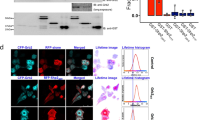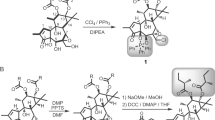Abstract
The phorbol ester 12-O-tetradecanoyl-phorbol-13-acetate (TPA) is an efficient tumour promoter in vivo. In vitro, TPA activates the phospholipid- and Ca2+-dependent protein kinase, kinase C1,2. This activation is believed to reflect the structural similarity between TPA and diacylglycerol, the endogenous protein kinase C activator which is produced in vivo by hydrolysis of phosphatidylinositol (reviewed in ref. 3). Protein kinase C phosphorylates protein substrates at serine and threonine residues in vitro2. The effects of TPA on cultured fibroblasts— including enhanced hexose uptake, disruption of actin stress fibres and growth stimulation—are very similar to those induced by certain retrovirus transforming proteins and by peptide growth factors such as epidermal growth factor (EGF), platelet-derived growth factor (PDGF) and multiplication-stimulating activity (MSA)4–7. These transforming proteins and mitogenic agents seem to act by inducing tyrosine-specific protein phosphorylation8–12. Such observations suggested that some of the effects of TPA in vivo may be mediated by protein phosphorylation at tyrosine residues. A 42,000-molecular weight (42 K) polypeptide was previously shown to be phosphorylated at tyrosine in cells transformed by avian sarcoma viruses10 and in cells stimulated by EGF, PDGF or MSA (J. Cooper, personal communication and refs 11 and 12; this polypeptide was originally designated 43 K or spot n in ref. 10). We show here that this polypeptide also becomes phosphorylated at tyrosine in cells treated with TPA. Furthermore, exogenously added diacylglycerol likewise stimulates the phosphorylation of this protein at tyrosine.
This is a preview of subscription content, access via your institution
Access options
Subscribe to this journal
Receive 51 print issues and online access
$199.00 per year
only $3.90 per issue
Buy this article
- Purchase on Springer Link
- Instant access to full article PDF
Prices may be subject to local taxes which are calculated during checkout
Similar content being viewed by others
References
Niedel, J. E., Kuhn, L. J. & Vanderbark, G. R. Proc. natn. Acad. Sci. U.S.A. 80, 36–40 (1983).
Castagna, M. et al. J. biol. Chem. 257, 7847–7851 (1982).
Nishizuka, Y. Trends biochem. Sci. 8, 13–16 (1983).
Blumberg, P. M. CRC crit. Rev. Tox. 8, 153–234 (1980–81).
Driedger, P. E. & Blumberg, P. M. Cancer Res. 37, 3257–3265 (1977).
Rifkin, D. B., Crowe, R. M. & Pollack, R. Cell 18, 361–368 (1979).
Weinstein, I. B., Lee, L. S., Fisher, P. B., Mufson, A. & Yamasaki, H. J. supramolec. Struct. 12, 195–208 (1979).
Hunter, T. & Sefton, B. Proc. natn. Acad. Sci. U.S.A. 77, 1311–1315 (1980).
Hunter, T. & Cooper, J. A. Cell 24, 741–752 (1981).
Cooper, J. A. & Hunter, T. Molec. cell. Biol. 1, 165–178 (1981).
Cooper, J. A., Bowen-Pope, D. F., Raines, E., Ross, R. & Hunter, T. Cell 31, 263–273 (1982).
Nakamura, K. D., Martinez, R. & Weber, M. J. Molec. cell. Biol. 3, 380–390 (1983).
Colby, C. & Edlin, G. Biochemistry 9, 917–920 (1970).
Rubin, R. A. & Earp, H. S. Science 219, 60–62 (1983).
Radke, K., Gilmore, T. & Martin, G. S. Cell 21, 821–828 (1980).
Erikson, E. & Erikson, R. Cell 21, 829–836 (1980).
Laszlo, A., Radke, K., Chin, S. & Bissell, M. J. Proc. natn. Acad. Sci. U.S.A. 78, 6241–6245 (1981).
Martin-Perez, J. & Thomas, G. Proc. natn. Acad. Sci. U.S.A. 80, 926–930 (1983).
Kaibuchi, K., Sano, K., Hoshijima, M., Takai, Y. & Nishizuka, Y. Cell Calcium 3, 323–335 (1982).
Rink, T. J., Sanchez, A. & Hallam, T. J. Nature 305, 317–319 (1983).
Ushiro, H. & Cohen, S. J. J. biol. Chem. 255, 8363–8365 (1980).
Ek, B., Westermark, B., Wasteson, A. & Heldin, C.-H. Nature 295, 419–420 (1982).
Kasuga, M., Zick, Y., Blithe, D. L., Crettaz, M. & Kahn, C. R. Nature 298, 667–669 (1982).
Lotem, J. & Sachs, L. Proc. natn. Acad. Sci. U.S.A. 76, 5158–5162 (1979).
Radke, K. & Martin, G. S. Proc. natn. Acad. Sci. U.S.A. 76, 5212–5216 (1979).
Author information
Authors and Affiliations
Rights and permissions
About this article
Cite this article
Gilmore, T., Martin, G. Phorbol ester and diacylglycerol induce protein phosphorylation at tyrosine. Nature 306, 487–490 (1983). https://doi.org/10.1038/306487a0
Received:
Accepted:
Issue Date:
DOI: https://doi.org/10.1038/306487a0
This article is cited by
-
Perspectives in physiology: cell growth
Pediatric Nephrology (1987)
Comments
By submitting a comment you agree to abide by our Terms and Community Guidelines. If you find something abusive or that does not comply with our terms or guidelines please flag it as inappropriate.



